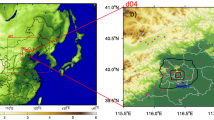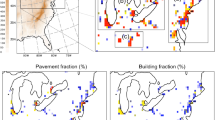Abstract
A new Canadian numerical urban modelling system has been developed at the Meteorological Service of Canada to represent surface and boundary-layer processes in the urban environment. In this system, urban covers are taken into account by including the Town Energy Balance urban-canopy parameterization scheme in the Global Environmental Multiscale meteorological model. The new modelling system is run at 250-m grid size for two intensive observational periods of the Joint Urban 2003 experiment that was held in Oklahoma City, U.S.A. An extensive evaluation against near-surface and upper-air observations has been performed. The Town Energy Balance scheme correctly simulates the urban micro-climate, more particularly the positive nighttime urban heat island, and also reproduces the “cool” island during the morning but does not succeed in maintaining it during all of the daytime period. The vertical structure of the boundary layer above the city is reasonably well simulated, but the simulation of the nocturnal boundary layer is difficult, due to the complex interaction with the nighttime southerly low-level jet that crosses the domain. Sensitivity tests reveal that the daytime convective boundary layer is mainly driven by dry soil conditions in and around Oklahoma City and that the nighttime low-level jet reinforces the urban heat island in the first 300m through large-scale advection, leading to the development of a less stable layer above the city.
Similar content being viewed by others
References
Allwine KJ, Leach MJ, Stockham LW, Shinn JS, Hosker RP, Bowers JF, Pace JC (2004) Overview of Joint Urban 2003—an atmospheric dispersion study in Oklahoma City. In: Planning, nowcasting, and forecasting in the urban zone symposium, 84th AMS annual meeting, Seattle, WA, USA
Balsamo G, Mahfouf J-F, Bélair S, Deblonde G (2007) A land data assimilation system for soil moisture and temperature: an information content study. J Hydrometeorol 8(6): 1225–1242
Bejarán RA, Camilloni IA (2003) Objective method for classifying air masses: an application to the analysis of Buenos Aires’ (Argentina) urban heat island intensity. Theor Appl Climatol 74: 93–103
Bélair S, Crevier L-P, Mailhot J, Bilodeau B, Delage Y (2003) Operational implementation of the ISBA land surface scheme in the Canadian regional weather forecast model. Part I: Warm season results. J Hydrometeorol 4: 352–370
Berg LK, De Wekker SFJ, Shaw WJ, Allwine KJ (2004) Observations of boundary-layer winds in an urban environment. In: 5th AMS symposium on urban environment, American Meteorological Society, Vancouver, BC, Canada
Blackadar AK (1957) Boundary layer wind maxima and their significance for the growth of nocturnal inversions. Bull Am Meteorol Soc 38(5): 283–290
Blackadar AK (1962) The vertical distribution of wind and turbulent exchange in a neutral atmosphere. J Geophys Res 67: 3095–3102
Bleeker W, André J (1951) On the diurnal variation of precipitation, particularly over centural U.S.A., and its relation to large-scale orographic circulation systems. Q J Roy Meteorol Soc 77: 260–271
Bonner WD (1968) Climatology of the low level jet. Mon Weather Rev 96(12): 833–850
Bornstein R, Lin Q (2000) Urban heat islands and summertime convective thunderstorms in Atlanta: three case studies. Atmos Environ 34: 507–516
Calhoun R, Heapa R, Princevacb M, Newsomc R, Fernandod H, Ligon D (2007) Virtual towers using coherent Doppler lidar during the Joint Urban 2003 dispersion experiment. J Appl Meteorol Climatol 45(8): 1116–1126
Chow W, Roth M (2006) Temporal dynamics of the urban heat island of Singapore. Int J Climatol 26(15): 2243–2260
Danko DM (1992) The digital chart of the world. GeoInfo Syst 2: 29–36
De Wekker SFJ, Berg LK, Allwine KJ, Doran JC, Shaw WJ (2004) Boundary-layer structure upwind and downwind of Oklahoma City during the Joint Urban 2003 field study. In: 5th AMS symposium on urban environment, American Meteorological Society, Vancouver, BC, Canada
Delage Y (1997) Parameterising sub-grid scale vertical transport in atmospheric models under statically stable conditions. Boundary-Layer Meteorol 82: 23–48
Delage Y, Girard C (1992) Stability functions correct at the free convection limit and consistent for both the surface and Ekman layers. Boundary-Layer Meteorol 58: 19–31
Erfani A, Mailhot J, Gravel S, Desgagné M, King P, Sills D, McLennan N, Jacob D (2005) The high resolution limited area version of the global environmental multiscale model and its potential operational applications. In: 11th conference on mesoscale processes, American Meteorological Society, Albuquerque, NM, USA
Fan H, Sailor DJ (2005) Modeling the impacts of anthropogenic heating on the urban climate of Philadelphia: a comparison of implementations in two PBL schemes. Atmos Environ 39(1): 73–84
Fast JD, Torcolini JC, Redman R (2005) Pseudovertical temperature profiles and the urban heat island measured by a temperature datalogger network in Phoenix, Arizona. J Appl Meteorol 44: 3–13
Figuerola PI, Mazzeo NA (1998) Urban-rural temperature differences in Buenos Aires. Int J Climatol 18: 1709–1723
Gedzelman SD, Austin S, Cermak R, Stefano N, Partridge S, Quesenberry S, Robinson DA (2003) Mesoscale aspects of the urban heat island around New York City. Theor Appl Climatol 75(1–2): 29–42
Heap RB, Calhoun R, Princevac M, Sommer J (2004) Lidar measurements of atmospheric flow through a downtown cluster of high-rise buildings. In: 5th AMS symposium on urban environment, American Meteorological Society, Vancouver, BC, Canada
Helfand HM, Schubert SD (1995) Climatology of the simulated Great Plains low-level jet and its contribution to the continental moisture budget of the United States. J Clim 8: 784–806
Hidalgo J, Masson V, Pigeon G (2008) Urban-breeze circulation during the CAPITOUL experiment: numerical approach. Meteorol Atmos Phys 102(3–4): 243–262
Kim YH, Baik JJ (2005) Spatial and temporal structure of the urban heat island in Seoul. J Appl Meteorol 44: 591–605
Lemonsu A, Masson V (2002) Simulation of a summer urban breeze over Paris. Boundary-Layer Meteorol 104: 463–490
Lemonsu A, Grimmond CSB, Masson V (2004) Modelisation of the surface energy budget of an old Mediterranean city core. J Appl Meteorol 43: 312–327
Lemonsu A, Pigeon G, Masson V, Moppert C (2006a) Sea-town interaction over Marseille: 3D urban boundary layer and thermodynamic fields near the surface. Theor Appl Climatol 84(1–3): 171–178
Lemonsu A, Bastin S, Masson V, Drobinski P (2006b) Vertical structure of the urban boundary layer over Marseille under sea-breeze conditions. Boundary-Layer Meteorol 118(3): 477–501
Lemonsu A, Leroux A, Bélair S, Trudel S, Mailhot J (2006c) A general methodology of urban cover classification for atmospheric modelling. In: 6th symposium on the urban environment, American Meteorological Society, Atlanta, GA, USA
Lenderink G, Holtslag AAM (2004) An updated lengthscale formulation for turbulent mixing in clear and cloudy boundary layers. Q J Roy Meteorol Soc 130: 3405–3427
Liu Y, Chen F, Warner T, Basara J (2006) Verification of a mesoscale data-assimilation and forecasting system for the Oklahoma City area during the Joint Urban 2003 field project. J Appl Meteorol Climatol 4(7): 912–929
Loveland TR, Reed BC, Brown JF, Ohlen DO, Zhu Z, Yang L, Merchant JW (2000) Development of a global land cover characteristics database and IGBP DISCover from 1 km AVHRR data. Int J Remote Sens 21(6–7): 1303–1330
Lundquist JK, Mirocha JD (2006) Interaction of nocturnal low-level jets with urban geometries as seen in Joint URBAN 2003 data. In: 6th symposium on the urban environment, American Meteorological Society, Atlanta, GA, USA
Mailhot J, Bélair S, Lefaivre L, Bilodeau B, Desgagné M, Girard C, Glazer A, Leduc A-M, Methot A, Patoine A, Plante A, Rahill A, Robinson T, Talbot D, Tremblay A, Vaillancourt P, Zadra A, Qaddouri A (2006) The 15- km version of the Canadian regional forecast system. Atmos Ocean 44(2): 133–149
Martilli A, Clappier A, Rotach MW (2002) An urban surface exchange parameterization for mesoscale models. Boundary-Layer Meteorol 104: 261–304
Masson V (2000) A physically-based scheme for the urban energy budget in atmospheric models. Boundary-Layer Meteorol 94: 357–397
Masson V, Grimmond CSB, Oke TR (2002) Evaluation of the Town Energy Balance (TEB) scheme with direct measurements from dry districts in two cities. J Appl Meteorol 41: 1011–1026
Mitchell MJ, Arritt RW, Labas K (1995) A climatology of the warm season Great Plains low-level jet using wind profiler observations. Weather Forecast 10: 576–591
Noilhan J, Planton S (1989) A simple parameterization of land surface processes for meteorological models. Mon Weather Rev 117: 536–549
Oke TR (1987) Boundary layer climates, 2nd edn. Methuen, London, p 435
Peagle J, Peagle N, McCorcle M, Miller E (1984) Diagnoses and numerical simulation of a low-level jet during ALPEX. Beitr Phys Atmos 57: 419–430
Pearlmutter D, Bitan A, Berliner P (1999) Microclimatic analysis of “compact” urban canyons in an arid zone. Atmos Environ 33(10): 4143–4150
Pigeon G, Legain D, Durand P, Masson V (2007) Anthropogenic heat release in an old European agglomeration (Toulouse, France). Int J Climatol 27(14): 1969–1981
Rosenzweig C, Solecki WD, Parshall L, Chopping M, Pope G, Goldber R (2005) Characterizing the urban heat island in current and future climates in New Jersey. Environ Hazards 6: 51–62
Sarrat C, Lemonsu A, Masson V, Guedalia D (2006) Impact of urban heat island on regional atmospheric pollution. Atmos Environ 40(10): 1743–1758
Song J, Liao K, Coulter RL, Lesht BM (2005) Climatology of the low-level jet at the Southern Great Plains atmospheric boundary layer experiments site. J Appl Meteorol 44: 1593–1606
Steinecke K (1999) Urban climatological studies in the Reykjavík subarctic environment Iceland. Atmos Environ 33: 4157–4162
Wang Y, Garvey DM, Klipp CL, Ligon DA, Williamson CC, Chang SS, Huynh GD, Calhoun R (2005) Low-level jet dominated atmospheric boundary layer observed by Doppler lidars over Oklahoma City during JU2003. In: Battlespace atmospheric and cloud impacts on military operations (BACIMO) conference, Monterey, CA, USA
Author information
Authors and Affiliations
Corresponding author
Rights and permissions
About this article
Cite this article
Lemonsu, A., Belair, S. & Mailhot, J. The New Canadian Urban Modelling System: Evaluation for Two Cases from the Joint Urban 2003 Oklahoma City Experiment. Boundary-Layer Meteorol 133, 47–70 (2009). https://doi.org/10.1007/s10546-009-9414-2
Received:
Accepted:
Published:
Issue Date:
DOI: https://doi.org/10.1007/s10546-009-9414-2




